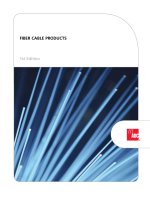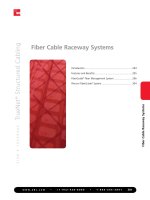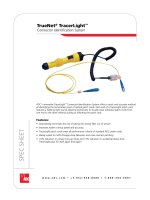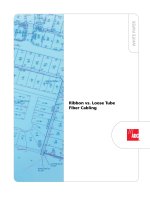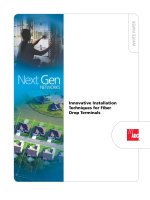Tài liệu Ribbon vs. Loose Tube Fiber Cabling pdf
Bạn đang xem bản rút gọn của tài liệu. Xem và tải ngay bản đầy đủ của tài liệu tại đây (269.99 KB, 4 trang )
WHITE PAPER
Ribbon vs. Loose Tube
Fiber Cabling
Ribbon vs. Loose Tube
Fiber Cabling
Making the Right Fiber Cable Choice can Improve Overall
Performance of Distribution Cables in the PON
In the distribution portion of the passive optical network (PON) for fiber-to-
the-premise (FTTP) architectures, the choice of fiber cabling – ribbon vs. loose
tube – can directly impact ease of installation and future performance. As is
usually the case in these networks, specific architectural characteristics and
particular applications may dictate the deployment of one type of cable over
the other. However, ADC’s experience in developing and manufacturing FTTP
network equipment has concluded that in most cases, ribbon cable provides a
considerable performance advantage over loose tube in the distribution portion
of the PON network.
Fiber Density is Key
The most obvious asset for ribbon cable is its higher fiber density. This is
particularly important for upstream applications requiring high fiber-count cables.
Material costs decrease since less plastic is involved and fewer strength members
are required. Additionally, it takes significantly less termination time (and cost)
with ribbon cable because of its mass fusion splicing capability as compared
to one-by-one fiber splicing. Even with techniques available for “ribbonizing”
loose tube fibers – basically stacking the fibers and using a spray adhesive to
simulate ribbon cable – for mass fusion splicing, using ribbon cable to begin with
eliminates the need for this extra step.
Ribbon is, therefore, a better choice for termination in areas of the network that
require a high volume of fibers. As the network branches farther out towards
the premise, the need for high fiber-count cables decreases. Once the density
becomes less than 144 fibers, loose tube cables have certain advantages. For
example, loose tube cables offer the ability to peel off single tubes to access
up to 12 fibers without disturbing the other fibers within the cable – even
when information is being transmitted through the rest of the cable. Although
this is possible with ribbon cable, it is a much more difficult operation since by
accessing one particular fiber, all the ribbons are exposed to activity that could
result in problems and even outages.
Page 3
Hybrid Designs
Hybrid ribbon and loose tube designs exist for some
applications. For these applications, ribbon stacks
are put into loose tubes and the tubes are stranded
together. Although this provides the ability to access
individual ribbons, dealing with the ribbon stack is still
less desirable. These cables tend to be much larger
and involve more plastic. Thus, much of the density
advantage is lost. They are also more expensive, and the
only advantage would be to gain higher fiber counts
than could be achieved using a central tube design.
Typically, cable vendors like Sumitomo Electric Lightwave,
offer ribbon cables that contain 864 fibers as compared
to 288 fibers in loose tube configurations. Although
higher density loose tube cables are possible, they
require more plastic – making them prone to attenuation
problems caused by expansion and contraction of the
plastic with varying temperatures. This leads to the need
for more strength members coupled to the elements to
ensure minimal shrinkage.
Connectorized Distribution Requires Ribbon Cable
Large loose tube cables are much more thermally
challenged than dense ribbon cables, making them
less ideal for the outside plant of the PON. However,
even the ribbon cable in the fiber distribution hub must
perform as intended over the temperature ranges.
It’s been ADC’s experience that for connectorized
distribution cabling inside the FDH, putting connectors
on ribbon cable works far better than any loose tube
cable because of the thermal expansion and contraction
of the sub-units.
In temperatures starting at about 32 degrees F, the
tubing in loose tube cables contracts substantially while
the fibers remain in place. This phenomenon induces
cable loss caused by attenuation in connectorized loose
tube distribution cables of as high as 10 dB. There are
only two ways to accommodate the expansion and
contraction of the sub-units. One way is to slit the
sub-unit material to make it “free-floating” over the
fibers. This isn’t recommended since it leaves multiple
fibers unprotected. The second alternative is simpler
– choose a vendor whose products exhibit less of this
phenomenon or who has achieved a time-tested way
to mitigate it. Most manufacturers of loose tube cable
recommend maximum tube lengths of 8 feet outside of
the OSP jacketing. Even at these lengths, ADC has often
observed considerable shrinkage of buffer tubes, leading
to temperature-induced losses at high wavelengths if the
cable assembly is not properly designed.
Ribbon cables simply do not have this problem. It’s
avoided by having all the cables in a central tube that
allows ample room for the fibers to move around as
sub-unit materials expand and contract. Although it may
not be considered a significant advantage, ribbon cables
eliminate the need for additional strength members to
prevent the end affects of temperature-induced cable
loss. However, it is one less operational step required and
ultimately saves additional space.
All Things Considered
Connectors are often advantagous at any location that
may require access for strategic testing or incremental
growth. While ADC never advocates replacing splices
with connectors when it doesn’t absolutely make sense,
using connectorized ribbon cables for distribution within
the PON of the FTTP system definitely makes sense. In
terms of restoration following a major event such as
a cut cable, it is much easier to restore a ribbon cable
versus a loose tube cable.
Since capital expense must inevitably be addressed at
some point when deploying an FTTP network, it may be
important to make a comparison between the relative
costs of ribbon versus loose tube cable. According to
Sumitomo Electric Lightwave, the cost of ribbon cable is
generally higher for fiber counts of 72 or less. For counts
above 72, the cost differential is less pronounced and
diminishes further as fiber counts increase.
There is no real cross-over point whereby ribbon cable
is less expensive then loose tube cable. However, most
customers are selecting ribbon cable on the basis of its
productivity, size, and other benefits that far outweigh
the initial cost differential.
All things considered, ADC has concluded that in feeder
cables where lower fiber counts are required, loose
tube cables are sometimes a good choice based on first
cost. However, on the distribution side of the FDH, a
connectorized ribbon cable simply performs far better
than a connectorized loose tube cable. When giving
careful consideration to issues such as size, density, and
restoration of cables, it appears ribbon cables are the
best choice.
Ribbon vs. Loose Tube Fiber Cabling
Web Site: www.adc.com
From North America, Call Toll Free: 1-800-366-3891 • Outside of North America: +1-952-938-8080
Fax: +1-952-917-3237 • For a listing of ADC’s global sales office locations, please refer to our Web site.
ADC Telecommunications, Inc., P.O. Box 1101, Minneapolis, Minnesota USA 55440-1101
Specifications published here are current as of the date of publication of this document. Because we are continuously
improving our products, ADC reserves the right to change specifications without prior notice. At any time, you may
verify product specifications by contacting our headquarters office in Minneapolis. ADC Telecommunications, Inc.
views its patent portfolio as an important corporate asset and vigorously enforces its patents. Products or features
contained herein may be covered by one or more U.S. or foreign patents. An Equal Opportunity Employer
101098AE 11/06 Revision © 2005, 2006 ADC Telecommunications, Inc. All Rights Reserved
WHITE PAPERWHITE PAPER




